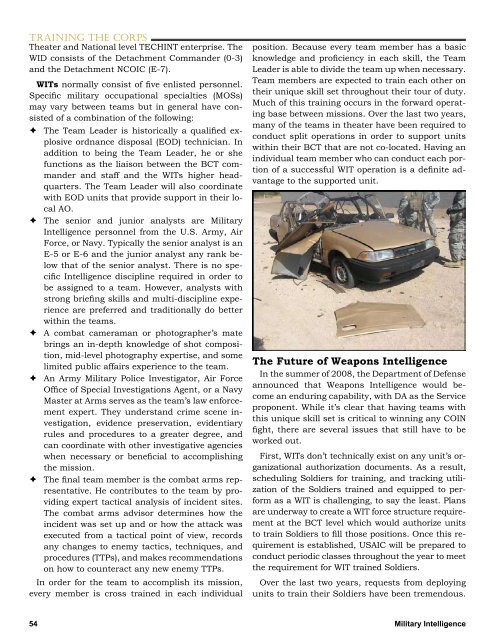Military Intelligence Professional Bulletin - Federation of American ...
Military Intelligence Professional Bulletin - Federation of American ...
Military Intelligence Professional Bulletin - Federation of American ...
You also want an ePaper? Increase the reach of your titles
YUMPU automatically turns print PDFs into web optimized ePapers that Google loves.
trAInInG tHE COrPs<br />
Theater and National level TECHINT enterprise. The<br />
WID consists <strong>of</strong> the Detachment Commander (0-3)<br />
and the Detachment NCOIC (E-7).<br />
WITs normally consist <strong>of</strong> five enlisted personnel.<br />
Specific military occupational specialties (MOSs)<br />
may vary between teams but in general have consisted<br />
<strong>of</strong> a combination <strong>of</strong> the following:<br />
Ê The Team Leader is historically a qualified explosive<br />
ordnance disposal (EOD) technician. In<br />
addition to being the Team Leader, he or she<br />
functions as the liaison between the BCT commander<br />
and staff and the WITs higher headquarters.<br />
The Team Leader will also coordinate<br />
with EOD units that provide support in their local<br />
AO.<br />
Ê The senior and junior analysts are <strong>Military</strong><br />
<strong>Intelligence</strong> personnel from the U.S. Army, Air<br />
Force, or Navy. Typically the senior analyst is an<br />
E-5 or E-6 and the junior analyst any rank below<br />
that <strong>of</strong> the senior analyst. There is no specific<br />
<strong>Intelligence</strong> discipline required in order to<br />
be assigned to a team. However, analysts with<br />
strong briefing skills and multi-discipline experience<br />
are preferred and traditionally do better<br />
within the teams.<br />
Ê A combat cameraman or photographer’s mate<br />
brings an in-depth knowledge <strong>of</strong> shot composition,<br />
mid-level photography expertise, and some<br />
limited public affairs experience to the team.<br />
Ê An Army <strong>Military</strong> Police Investigator, Air Force<br />
Office <strong>of</strong> Special Investigations Agent, or a Navy<br />
Master at Arms serves as the team’s law enforcement<br />
expert. They understand crime scene investigation,<br />
evidence preservation, evidentiary<br />
rules and procedures to a greater degree, and<br />
can coordinate with other investigative agencies<br />
when necessary or beneficial to accomplishing<br />
the mission.<br />
Ê The final team member is the combat arms representative.<br />
He contributes to the team by providing<br />
expert tactical analysis <strong>of</strong> incident sites.<br />
The combat arms advisor determines how the<br />
incident was set up and or how the attack was<br />
executed from a tactical point <strong>of</strong> view, records<br />
any changes to enemy tactics, techniques, and<br />
procedures (TTPs), and makes recommendations<br />
on how to counteract any new enemy TTPs.<br />
In order for the team to accomplish its mission,<br />
every member is cross trained in each individual<br />
position. Because every team member has a basic<br />
knowledge and pr<strong>of</strong>iciency in each skill, the Team<br />
Leader is able to divide the team up when necessary.<br />
Team members are expected to train each other on<br />
their unique skill set throughout their tour <strong>of</strong> duty.<br />
Much <strong>of</strong> this training occurs in the forward operating<br />
base between missions. Over the last two years,<br />
many <strong>of</strong> the teams in theater have been required to<br />
conduct split operations in order to support units<br />
within their BCT that are not co-located. Having an<br />
individual team member who can conduct each portion<br />
<strong>of</strong> a successful WIT operation is a definite advantage<br />
to the supported unit.<br />
The Future <strong>of</strong> Weapons <strong>Intelligence</strong><br />
In the summer <strong>of</strong> 2008, the Department <strong>of</strong> Defense<br />
announced that Weapons <strong>Intelligence</strong> would become<br />
an enduring capability, with DA as the Service<br />
proponent. While it’s clear that having teams with<br />
this unique skill set is critical to winning any COIN<br />
fight, there are several issues that still have to be<br />
worked out.<br />
First, WITs don’t technically exist on any unit’s organizational<br />
authorization documents. As a result,<br />
scheduling Soldiers for training, and tracking utilization<br />
<strong>of</strong> the Soldiers trained and equipped to perform<br />
as a WIT is challenging, to say the least. Plans<br />
are underway to create a WIT force structure requirement<br />
at the BCT level which would authorize units<br />
to train Soldiers to fill those positions. Once this requirement<br />
is established, USAIC will be prepared to<br />
conduct periodic classes throughout the year to meet<br />
the requirement for WIT trained Soldiers.<br />
Over the last two years, requests from deploying<br />
units to train their Soldiers have been tremendous.<br />
54 <strong>Military</strong> <strong>Intelligence</strong>
















